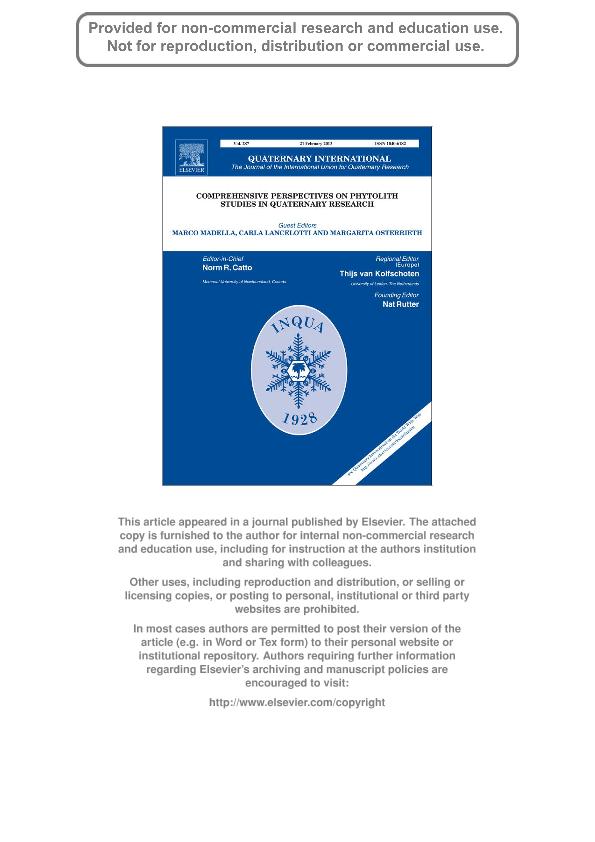Mostrar el registro sencillo del ítem
dc.contributor.author
Babot, Maria del Pilar

dc.contributor.author
Hocsman, Salomón

dc.contributor.author
Cattaneo, Gabriela Roxana

dc.date.available
2017-01-09T19:28:22Z
dc.date.issued
2013-02
dc.identifier.citation
Babot, Maria del Pilar; Hocsman, Salomón; Cattaneo, Gabriela Roxana; Assessing the life history of projectile points/knives from the Middle Holocene of Argentina’s Southern Puna; Elsevier; Quaternary International; 287; 2-2013; 3-19
dc.identifier.issn
1040-6182
dc.identifier.uri
http://hdl.handle.net/11336/10988
dc.description.abstract
Lithic artifacts that belong to hunter-gatherer occupations from the Quebrada Seca 3 site during the Middle Holocene of the Southern Puna of Argentina, dating to ca. 4800e5900 cal BP are analyzed. These tools have been defined as stemmed projectile points whose blades were intensively maintained, resulting in asymmetric shapes. However, they have also been defined as knives because of their morphology when discarded. To establish a more complete version of the life history of these artifacts, from projectile points to knives, a research design was developed that includes several analytical microscopic and compositional techniques to identify the uses that were preserved over time. Information obtained through microwear analysis and the study of microscopic residues -microfossils and chemical residues e on the blades and stems indicates that these artifacts were used in several functions, with a first use as projectile points and a final use as knives in generalized plant and animal processing. The plant material processed includes roasted or dehydrated tuberous/roots. The tools were also used to cut animal skin, flesh and/or bone. Evidence for hafting to foreshafts or handles and for the use of adhesives was also found. The use-traces and life history results were mutually consistent. This contributed to the discussion of artifact life history and resource processing by the Middle Holocene hunter-gatherers of the South Central Andes.
dc.format
application/pdf
dc.language.iso
eng
dc.publisher
Elsevier

dc.rights
info:eu-repo/semantics/openAccess
dc.rights.uri
https://creativecommons.org/licenses/by-nc-nd/2.5/ar/
dc.subject
Projectile Point
dc.subject
Southern Argentine Puna
dc.subject
Middle Holocene
dc.subject
Stone Tool Life History
dc.subject
Microfossil
dc.subject
Microwear Analysis
dc.subject.classification
Arqueología

dc.subject.classification
Historia y Arqueología

dc.subject.classification
HUMANIDADES

dc.title
Assessing the life history of projectile points/knives from the Middle Holocene of Argentina’s Southern Puna
dc.type
info:eu-repo/semantics/article
dc.type
info:ar-repo/semantics/artículo
dc.type
info:eu-repo/semantics/publishedVersion
dc.date.updated
2017-01-06T20:03:53Z
dc.journal.volume
287
dc.journal.pagination
3-19
dc.journal.pais
Países Bajos

dc.journal.ciudad
Amsterdam
dc.description.fil
Fil: Babot, Maria del Pilar. Consejo Nacional de Investigaciones Científicas y Técnicas. Centro Científico Tecnológico Tucumán. Instituto Superior de Estudios Sociales; Argentina. Universidad Nacional de Tucumán. Facultad de Ciencias Naturales e Instituto Miguel Lillo. Instituto de Arqueología y Museo; Argentina
dc.description.fil
Fil: Hocsman, Salomón. Consejo Nacional de Investigaciones Científicas y Técnicas. Centro Científico Tecnológico Tucumán. Instituto Superior de Estudios Sociales; Argentina. Universidad Nacional de Tucumán. Facultad de Ciencias Naturales e Instituto Miguel Lillo. Instituto de Arqueología y Museo; Argentina
dc.description.fil
Fil: Cattaneo, Gabriela Roxana. Universidad Nacional de Cordoba. Facultad de Filosofia y Humanidades. Museo de Antropologia; Argentina. Consejo Nacional de Investigaciones Científicas y Técnicas; Argentina
dc.journal.title
Quaternary International

dc.relation.alternativeid
info:eu-repo/semantics/altIdentifier/doi/http://dx.doi.org/10.1016/j.quaint.2012.02.048
dc.relation.alternativeid
info:eu-repo/semantics/altIdentifier/url/http://www.sciencedirect.com/science/article/pii/S1040618212001292
Archivos asociados
